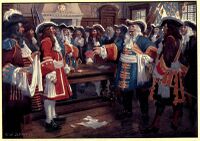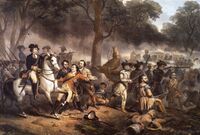Louvian Revolutionary War
From Kwikipedia, the free encyclopaedia
| Louvian Revolutionary War | |||||||||
|---|---|---|---|---|---|---|---|---|---|
 Important events of the war | |||||||||
| |||||||||
| Belligerents | |||||||||
| |||||||||
| Commanders and leaders | |||||||||
| Strength | |||||||||
| 42,000 regulars and militia |
48,000 regulars 15'000 loyalists | ||||||||
| Casualties and losses | |||||||||
|
9,650 dead in battle 7,100 wounded | 10,500 dead in battle | ||||||||
The Louvian Revolutionary War(September 5, 1758 – July 15, 1761) secured a Louvier independent from Lysian Republic. It is also called Guerre d'Indépendance de Louvier in Lysian. Fighting began on September 5, 1758, followed by the Declaration of Independence on October 6, 1758. The Louvian Patriots were supported by the Wampanoag Empire conflict taking place in Aurelia.
Causes
The unrest in the remote metropolis of Lysia had been stirring public opinion since 1755. In addition, the harsh winters of 1745 and 1750 were still felt and led the governor to tax the population even more to succeed in filling the financial abyss that affected the kingdom. Unrest soon broke out in the main towns of the colony such as Montvert, Saint-Philippe and Hautes-Plaines. Understanding that the situation was becoming tense in the colony, a first garrison of 5,000 men was sent to Saint-Philippe to support the soldiers already there. This only exacerbated the discontent of the population and, despite attempts at slight changes to the taxes put in place by Jean-Louis Meunier, soon the aristocrats of the colony began to secretly prepare an uprising to eliminate the unjust taxes.
Rupture
On September 5, 1758, an angry crowd gathered in front of Saint-Philipe's Town Hall to exert pressure. Following a misunderstanding or confusion, the garrison stationed in front of the town hall fired on the crowd, killing 12 people. It did not take more than that for the colonists' opinion on Lysia to fall drastically to be seen as an enemy. The evening after the massacre, the aristocrats helped by some military leaders including a captain named Antoine de Marelle, met in Pierre Lignoy's apartments and began to draft a declaration of independence. Declaring themself free from Lysian oppression and temporarily appointing a National Committee (In Lysian : Comité National) while waiting for a monarch. Posters began to be distributed to all towns and villages to announce independence. Opinion was divided: In the West the Louvians rejoiced at this news while in the East such a decision was castigated and openly criticized this aggressive approach. The two camps were now formed: the Loyalists and the Lysians in the East and the Patriots in the West.
Outbreak of war
The first fighting was unleashed at Fort Beauregard in early November, where the garrison refused to open to Lysian soldiers. To the cry of "Vive la liberté et vive Louvier!", the soldiers entrenched in the fort shot at the Lysians who had to quickly retreat. As the first ships of Lysian troops arrived to help in the future conflict that was coming, the governor of Saint-Philippe, now entrenched in Port-du-Roy, announced that: "All persons taking up arms against the Lysian crown will be punished by death." An army of Loyalists was quickly set up under the supervision of General Henri Moulin. The first real confrontation was at Saint-Philippe in December where the militiamen defended the city against the loyalists supported by the Lysian troops. The city held firm and General Sébastien Pierrac had to retreat with 300 casualties.
On November 13, 1758, Exarchate of Kirvina declared war on Lysia and its full support for its struggle for independence. A general named Nikolaos Balaskas and 1,000 men arrived to lend their support and train the militiamen. This news delighted the insurgents and pushed them to redouble their efforts in the struggle.
On December 28, 1758, loyalist troops led by Etienne Villeney on their way to Fleur-de-Lys were ambushed by natives and militiamen. The troops were almost all massacred and despite the national committee's request to try to take prisoners, the Indians showed nameless savagery and scalped the loyalist soldiers without the militiamen intervening to stop them. Captain Etienne Villeney was killed in this ambush of a tomahawk in the back.
Soon the lack of powder was felt for the Patriots, the reserves being at Prévert in Loyalist territory. It was necessary as soon as possible to try to take the city to supply the militia and the very recent Army of Louvier was sent to besiege the city. A naval expedition was authorized and the city was besieged from January 7, 1759 to January 12. As the winter made it difficult to arrive food, the city agreed to provide stocks of powder if the citizens were left in peace. Soon the announcement of a Lysian army approaching to rescue the city, shortened the time the Patriots had to load the powder. The ships left the port just in time before reinforcements arrived in the distance.
Lysian counter-offensive
After regrouping at Port-du-Roy, Henri Moulin was determined to take the fight to the Louvians. He sailed for Saint-Philippe in February 1759 and began landing troops. The Louvians rejected Moulin's informal attempt to negotiate peace. The new elected general Antoine de Marelle knew that an attack on the city was imminent and realized that he needed advance information to deal with disciplined Lysian regular troops.
De Marelle split his army into positions on the plain in front of thec city and across. On February 21 at the Battle of Grand-Deuil, Moulin outflanked De Marelle and forced him back to Saint-Philippe. De Marelle ordered the assembly of a war council on February 29; all agreed to retreat to Montvert.
General Moulin officially met with a delegation from National Committee at the February Peace Conference, but it failed to conclude peace as the Lysian delegates only had the authority to offer pardons and could not recognize independence. On March 5, Howe seized control of Saint-Philippe when the Lysians landed and unsuccessfully engaged the Louvians at the Battle of Vertpied the following day. On March 8 Moulin failed to encircle the Louvians at the Battle of Blanche, and the Louvians withdrew.
De Marelle's retreat isolated his remaining forces and the Lysians captured Fort Lebeau on March 16. The Lysian victory there amounted to De Marelle's most disastrous defeat with the loss of 2,000 prisoners. In Lyrie they rejoiced at the victorious news of Moulin and patiently expected the insurgents to capitulate by the end of the year at the latest.
Louvian resurgence
The fall of Saint-Philippe and the advance of the Loyalist and Lysian armies seriously damaged the morale of the Patriots. The Louvian general staff had to crack down several times because desertions and mutinies broke out here and there. New officers were appointed such as Laspalette and Montfaucon, former soldiers who had served in the high-ranking ranks of the colonial army of Lysia.
After consultation with De Marelle, it was decided to conduct ambushes in the south to attract the Lysian armies, while the Louvian armies will advance northwards. Military reform was also instituted. The soldiers would learn discipline and coordination from foreign generals sent to support the insurgents. Tailor-made uniforms were created, in white color, symbol of freedom and peace.
Montfaucon and Laspalette were sent south to conduct raids and ambushes to lure Moulin's armies. He was at the head of militiamen who were mostly trappers,loggers and some native tribesmen but who possessed a knowledge of camouflage. The companies under Montfaucon and Laspalette were called "Les Buissons". The raids and ambushes in the south quickly attracted the attention of General Moulin who asked Geoffrey Bouillon to bring his men to the south and park in the city of Fleur-de-vent. The troops arrived in the South in April 17, 1759. Montfaucont proposed to conduct a substantial raid on Fort Baie Blanche, a strategic point that guarded Lac Grand-Ciel. On April 21, militiamen from the "Buissons" undertook to cross the Lake at night to reach the Fort. As they docked, they were spotted by a patrol. Montfaucon ordered the charge but was shot in the heart. Laspalette now alone, he preferred to order the retreat while lighting a blaze to ignite the fort. The attack cost the militiamen dearly but allowed even more attention to be drawn to the South and worried Moulin even more. General de Marelle was deeply touched by Montfaucon's death saying of him in his memoirs : "It is with a tight heart that I learned the death of the bravest officer of this struggle for freedom."
End of 1759
The hasty advance of part of Henri Moulin's troops to assist Geoffrey Bouillon allowed De Varelle to quickly launch a counter-attack to the north. The invasion was stopped with the improbable Lysian victory in the Battle of Bresson, in which 3,600 Loyalists defeated De Méricourt's force of 10,000 regulars, militia, and Indian allies. De Méricourt saved something from the disaster when he sent Fleurit on an expedition that successfully destroyed Fort Vernet.
The blockade of the ships of the Lysian fleet along the coast prevented any supply of the Patriots, as well as the supply convoys intended for the loyalists were heavily monitored. This blockade, which had lasted since the beginning of February, had to be stopped. De Marelle asked Admiral Lignoy to attempt a breakthrough east of the blockade. On October 4, 1759, a large part of the insurgent fleet confronted the Lysian fleet at Réchy. But the naval superiority of the Lysians tipped the scales and the fleet was crushed, Lignoy losing his life in the battle. The blockade held firm throughout 1759.


